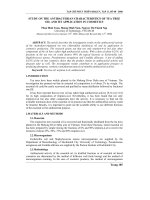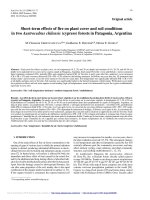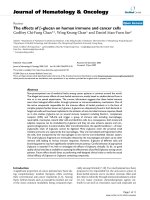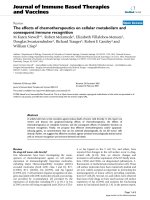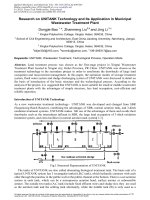Effects of TiO2 on chitosan film and its application in passion fruit preservation
Bạn đang xem bản rút gọn của tài liệu. Xem và tải ngay bản đầy đủ của tài liệu tại đây (7.36 MB, 110 trang )
MINISTRY OF EDUCATION AND TRAINING
HO CHI MINH CITY UNIVERSITY OF
TECHNOLOGY AND EDUCATION
GRADUATION THESIS
Major: FOOD TECHNOLOGY
Effects of TiO2 on chitosan film and its application
in passion fruit preservation
LECTURER: TRAN THI NHUNG
STUDENT: LE THUY TUONG VAN
SKL 009135
Ho Chi Minh City, November 2020
\HO CHI MINH UNIVERSITY OF TECHNOLOGY AND EDUCATION
FACULTY FOR HIGH QUALITY TRAINING FOOD TECHNOLOGY
DEPARTMENT OF FOOD TECHNOLOGY
GRADUATION THESIS
ID: 2022-18116029
Effects of TiO2 on chitosan film and its application in
passion fruit preservation
NGUYEN LE ANH PHUONG
18116029
LE HOANG QUAN
18116032
Major: FOOD TECHNOLOGY
Supervisor: TRAN THI NHUNG, PROF.
HO CHI MINH CITY – AUGUST 2022
HO CHI MINH UNIVERSITY OF TECHNOLOGY AND EDUCATION
FACULTY FOR HIGH QUALITY TRAINING FOOD TECHNOLOGY
DEPARTMENT OF FOOD TECHNOLOGY
GRADUATION PROJECT
Thesis code 2022-18116029
EFFECTS OF TIO2 ON CHITOSAN FILM
AND ITS APPLICATION IN PASSION FRUIT
PRESERVATION
NGUYEN LE ANH PHUONG
18116029
LE HOANG QUAN
18116032
Major: FOOD TECHNOLOGY
Supervisor: TRAN THI NHUNG, Ph.D
Ho Chi Minh City – August 2022
Table of content
GRADUATION THESIS ASSIGNMENT .................................................... Error! Bookmark not defined.
Table of content .......................................................................................................................................... iii
List of Figures .............................................................................................................................................. v
Chapter 1: INTRODUCTION ................................................................................................................... 2
1.1.
Pose the problem ............................................................................................................................. 2
1.2.
Topic goal ......................................................................................................................................... 3
1.3.
Subject and scope of research ........................................................................................................ 3
1.4.
Research content ............................................................................................................................. 3
1.5.
The scientific and practical significance of the topic .................................................................... 4
Chapter 2: OVERVIEW............................................................................................................................. 5
2.1.
Titanium Dioxide ............................................................................................................................. 5
2.1.1.
Overview of titanium dioxide ................................................................................................. 5
2.1.2.
TiO2 application....................................................................................................................... 5
2.1.2.1.
Pigment............................................................................................................................. 6
2.1.2.2.
Thin films ......................................................................................................................... 7
2.1.2.3.
Sunscreen and UV blocking pigments ........................................................................... 7
2.1.2.4.
TiO2 photocatalysis.......................................................................................................... 8
2.1.2.5.
Health and safety ............................................................................................................. 9
2.2.
Chitosan .........................................................................................................................................11
2.3.
Isopropyl alcohol ...........................................................................................................................11
2.4.
Passion fruit ...................................................................................................................................13
2.4.1.
Overview of passion fruit ......................................................................................................13
2.4.2.
Nutrition value of passion fruit ............................................................................................14
2.4.3.
Fruit ripening process ...........................................................................................................14
2.5.
Effect of irradiation on the experiment .......................................................................................17
2.6.
Research on fruit preservation.....................................................................................................18
2.7.
Reasons for choosing a research topic .........................................................................................20
Chapter 3: MATERIAL AND METHODS ............................................................................................22
Materials and methods......................................................................................................................22
3.
3.1.
Materials ........................................................................................................................................22
3.2.
Equipment ......................................................................................................................................22
Research process diagram ....................................................................................................................22
3.3.
Method ...........................................................................................................................................24
iii
3.3.1.
Synthetic TiO2 .......................................................................................................................24
3.3.2.
Preparation of chitosan films coated with TiO2 to cover the fruit ...................................24
3.3.3.
Preparation of chitosan films coated with TiO2 on petri dish ..........................................25
3.3.3.1.
Experimental arrangement to determine the effects of TiO2 on chitosan films ......25
3.3.3.2.
Method to determine the moisture content of chitosan films ....................................25
3.3.3.3.
Some mechanical properties of chitosan films. ...........................................................26
3.3.3.4.
The absorption spectrum and light transmittance .....................................................26
3.3.3.5.
The Water Vapor Permeability (WVP).......................................................................27
3.3.4.
Passion fruit hardness experiment .......................................................................................27
3.3.5.
Passion fruit weight loss experiment ...................................................................................27
3.3.6.
Passion fruit colorimetric experiment .................................................................................28
3.3.7.
Experimental arrangement to determine the amount of gas released by passion fruit ..30
3.3.7.1.
FTIR analysis method ...................................................................................................32
CHAPTER 4: RESULT AND DISCUSSION .........................................................................................34
4.1.
Synthesis of TiO2...........................................................................................................................34
4.2.
Effect of TiO2 on properties of chitosan films ............................................................................34
4.2.1.
Moisture content ....................................................................................................................34
4.2.2.
Effect of TiO2 on the swelling degree of the chitosan film ................................................36
4.2.3.
Effect of TiO2 on the solubility of the chitosan film...........................................................37
4.2.4.
.Effect of TiO2 on the Moisture permeability of the chitosan film ..................................38
4.2.5.
UV-vis Absorption spectrum and light transmittance of the film ....................................39
4.2.6.
FTIR of synthetic TiO2 and commercial TIO2 ..................................................................40
4.2.7.
Mechanical Properties of TiO2 and commercial TiO2 with chitosan film ........................41
4.3.
Application of TiO2- Chitosan films on passion fruit preservation..........................................45
4.3.1.
Color test ................................................................................................................................45
4.3.1.1.
Sample with UV and sample without UV ....................................................................47
4.3.1.2.
Cold temperature (5oC) and room temperature (25oC) samples...............................48
4.3.2.
Weight loss .............................................................................................................................50
4.3.2.1.
Samples with different amount of TiO2 ......................................................................50
4.3.2.2.
Samples with UV under cold temperature and room temperature ..........................52
4.3.2.3.
Samples with UV and without UV ...............................................................................52
4.3.3.
Effect of hardness on fruit ripening .....................................................................................53
4.3.3.1.
Passion fruit's hardness without UV exposure ...........................................................53
4.3.3.2.
Passion fruit's hardness with UV exposure .................................................................55
4.3.3.3.
Compare the difference hardness when storage at different temperature and
different type of TiO2 .......................................................................................................................56
iv
4.3.4.
Determine the amount of gas released during the ripening of passion fruit ....................58
CHAPTER 5: CONCLUSION .................................................................................................................60
Appendix ....................................................................................................................................................66
List of Figures
Figure 1. 1 Biggest passion fruit producer in the world ............................................................ 3
Figure 2. 1: Titanium dioxide powder .........................................................................................5
Figure 2. 3: Application of TiO2 ...................................................................................................6
Figure 2. 4: Marshmallow which have TiO2 as pigment ............................................................ 7
Figure 2. 5: Application of TiO2 in thin film which use in energy film ....................................7
Figure 2. 6: Sunscreen product ....................................................................................................8
Figure 2. 7: Mechanical of TiO2 photocatalysis ..........................................................................9
Figure 2. 8 Chitosan production process ...................................................................................11
Figure 2. 9: chemical composition of isopropyl alcohol ........................................................... 12
Figure 2. 10: passion fruit ...........................................................................................................14
Figure 2. 11: Ethylene effect to fruit ripening ..........................................................................15
Figure 2. 12: Ethylene release of climacteric fruits and non-climacteric fruits.....................16
Figure 2. 13: Irradiation on plants ............................................................................................. 18
Figure 2. 14: Cold storage ...........................................................................................................19
Figure 2. 15 Atmospheric preservation .....................................................................................19
Figure 2. 16: KmnO4 ...................................................................................................................20
Figure 2. 17: current situation of VN agriculture.....................................................................21
Figure 3. 1: research process diagram .......................................................................................24
Figure 3. 3: Hue angle (h0) formula ........................................................................................... 30
Figure 3. 4: Sky2000 ....................................................................................................................32
Figure 3. 5: Machine FT/IR-4700 Jasco, Japan ........................................................................33
Figure 4. 1:Compare the moisture content of TiO2 chitosan films .......................................................35
Figure 4. 2: Swelling degree of TiO2 – chitosan films ............................................................................36
Figure 4. 3; Effect of TiO2 on the solubility of the chitosan film .........................................................37
Figure 4. 4: Effect of TiO2 on the moisture permeability of the film in 12th hour ..............................39
Figure 4. 5: Light transmittance of chitosan and chitosan films incorporating TiO2 ........................40
Figure 4. 6: FTIR spectra of TIO2...........................................................................................................41
Figure 4. 7 Tensile strength of synthetic TiO2 and commercial TiO2 with chitosan film ...................42
Figure 4. 8: Elongation of synthetic TiO2 and commercial TiO2 with chitosan film ...........................43
v
Figure 4. 9: Thickness of chitosan film with synthetic TiO2 and commercial TiO2 ............................44
Figure 4. 10: Angle hue (h0) formula .......................................................................................................46
Figure 4. 11: L of samples with and without UV ....................................................................................47
Figure 4. 12: The hue angles of samples with and without UV .............................................................48
Figure 4. 13:L of TiO2-chitosan film under cold temperature and room temperature ......................49
Figure 4. 14 The hue angles color of samples under cold temperature and room temperature ........50
Figure 4. 15: Weigh loss of samples with different amount percentage of TiO2 in chitosan solution.
.....................................................................................................................................................................51
Figure 4. 16: Weight loss between samples with TiO2 in chitosan solution under cold temperature
(5oC) and control sample of room temperature after 4 days .................................................................52
Figure 4. 17: Line chart show weight loss of sample with and without UV treating after 6 days ......53
Figure 4. 18: The line graph of the hardness change of passion fruit without UV irradiation ..........55
Figure 4. 19: The line graph of the hardness change of passion fruit with UV irradiation ................56
Figure 4. 20: Compare the difference hardness when storage with prepared TiO2 and commercial
TiO2. ...........................................................................................................................................................57
Figure 4. 21: Compare the difference hardness when storage at different temperature ....................58
Figure 4. 22: Change in ethylene gas during storage .............................................................................59
Figure 4. 23: photolysis of ethylene gas with TIO2 at 25oC and 12oC .................................................59
vi
List of Tables
Table 2. 1: Nutritional composition of passion fruit per 100g .................................................14
Table 2. 3: Some fruits emit ethylene gas ..................................................................................16
Table 3. 1: Preparation of chitosan films coated with TiO2 modulated .................................24
Table 3. 3: Preparation of chitosan films coated with commercial TiO2 ............................... 25
Table 4. 1: The moisture content of chitosan films and chitosan combine with TiO2 ..........35
Table 4. 2: Swelling degree of the chitosan film and chitosan films combine with TiO2 .....36
Table 4. 3: Solubility of the chitosan film and chitosan films combine with TiO2 ................37
Table 4. 4: Moisture permeability of the film in 15th hour ......................................................39
Table 4. 5: Elongation of synthetic TiO2 and commercial TiO2 with chitosan film ..............43
Table 4. 6: Thickness of chitosan film with synthetic TiO2 and commercial TiO2 ................45
Table 4. 7: Formula of calculating weight loss percent ............................................................ 50
Table 4. 8: Weigh loss of samples with different amount percentage of TiO2 in chitosan
solution..........................................................................................................................................50
Table 4. 9: Prediction of fruit hardness during ripening ......................................................... 54
vii
Abstract
Nowadays, sustainable agriculture has recently become a significant source of concern.
Governments and municipal governments must ensure that large amounts of food are not wasted.
Food waste is a huge global concern, especially now that the Covid-19 epidemic threatens to
increase the number of people facing food shortages. According to the NLD newspaper, onethird of all food produced for human use is lost or wasted globally. In Vietnam, MSc Duong Thi
Thu Hang, Institute of Agricultural Electromechanical Engineering and Post-Harvest
Technology - Ministry of Agriculture and Rural Development, quoted a CEL Consulting survey
indicating that post-harvest losses are now low. 20% to 25%, costing 3.9 billion USD each year.
The fruit and vegetable industry has the most significant loss rate, accounting for around 32% of
output, or 7.3 million tons per year. Excessive waste of agricultural products hurts the country's
economy. Hence agricultural product preservation is becoming more concentrated and
encouraged to be developed in more profound research. Fruit ripening is a series of processes
that alter the fruit's color, weight, and material content. Fruit quality qualities fluctuate as they
progress through growth and development phases. Typically, ripe fruit is soft, the sugar content
increases, and the acid level decreases. The aroma volatiles is released, and the fruit's genuine
flavour develops. The plant hormone ethylene plays a crucial function in fruit ripening.
Generally, an immature fruit has low quantities of ethylene. As a signal for fruit ripening,
ethylene is released as the fruit matures. After harvest, ethylene production rises, reducing the
fruit's shelf life, storage capacity, and vulnerability to disease attacks. This research focuses on
the influence of TiO2 on the membrane properties and then applies to the antioxidant activity of
innovative polysaccharide-based membranes, including chitosan (CH) and isopropyl alcohol,
with the support of titanium dioxide was irradiated with a UV lamp to treat passion fruit
ethylene emissions. Chitosan is added to glycerol at a ratio of 30% glycerol/chitosan to enhance
the strength of the film, making it more difficult for the film to break during storage. The results
showed that passion fruit preserved by covering with chitosan film and titanium dioxide had
physical properties that were not much different from passion fruit stored under normal
conditions. During storage, chitosan-coated fruits produced more ethylene gas than control
samples stored at the same temperature and pressure conditions.
1
Chapter 1: INTRODUCTION
1.1.Pose the problem
The ethylene gas which is known as the fruit ripening hormone is the primary factor in fruit and
vegetable postharvest deterioration. Reducing the amount of ethylene gas will help to slow down
ripening. Using active package which is combined with TiO2 likes ethylene scavengers. Because
of the double bond, gaseous ethylene is a highly reactive chemical that can be altered or broken
down in a variety of ways [1]. Ethylene scavenging can be done by chemical or physical
methods [2]. Gaseous ethylene is photocatalytically oxidized by being exposed to ultraviolet
(UV) radiation and using a catalyst, such as titanium dioxide (TiO2). There are not many
scientific articles on the application of tio2 screens to the ripening rate of fruits. This is the
primary reason for choosing tio2 as ethylene scavager.
During the pre-lockdown, lockdown, and second-wave periods of COVID-19 in Vietnam,
according to the study, the number of daily COVID-19 confirmed cases in Vietnam has a
detrimental effect on the stock returns of publicly traded companies[3]. Agricultural products
from the West are transshipped to Lang Son for export to China, mainly Thai jackfruit and
dragon fruit. These are seasonal crops. Nearly 5,000 containers of fruit, each truck with a
capacity of 20 tons, roughly hundreds of thousands of tons of fruit, if we continue to wait for
customs clearance[4]. Tien Giang is known as the "Fruit Garden" of the country with a growing
area of more than 80,000 hectares. But not only dragon fruit, the price of many other fruits in the
province has "bottomed out" due to… Corona virus [5]. With strong growth value, passion fruit
tree has brought high economic efficiency compared to many other crops, created jobs and
brought a great source for many farmers and businesses. In 2021, Vietnam accounts for 5.4% of
the world's passion fruit production and ranks 7th in passion fruit production. By extending the
period of ripening time, the consumption of lemons will increase and the loss of passion fruit due
to over ripeness will decrease. This is the second purpose to test TiO2 chitosan film on passion
fruit to prolong.
In the study, by using 2 different type of TiO2, we can investigate the method of producing of
TiO2 can affect to photocatalytic of TiO2 which can understand more to effectively made
synthetic TiO2. Some study points the calcinating process can affect much to the size and
photocatalytic of TiO2. By imitate the producing process, we can understand the synthetic TiO2.
2
tonnes
800000
700000
600000
500000
400000
300000
200000
100000
0
tonnes
Figure 1. 1 Biggest passion fruit producer in the world
1.2.Topic goal
- Determine physical properties of synthesis TiO2
- Determine effect of TiO2 film to passion fruit ripening
- Determine properties of Chitosan films combining TiO2
1.3. Subject and scope of research
Subject:
-
Synthesis of TiO2
TiO2 – chitosan film
Passion fruit is treated by Chitosan films combining TiO2
Research scope:
-
The study determines synthesis of TiO2 production
The study determines physical properties of chitosan film combining with TiO2
The study determines the application and effect of TiO2 – chitosan film (color, harness,
weight loss, gas release)
- The study is done at food technology industry laboratory, University of Technology and
Education, Ho Chi Minh city
1.4. Research content
- Effect of TiO2 to chitosan film including:
+ Moisture
+ Swelling degree
+ Solubility, moisture permeability
+ UV-vis absorption spectrum and light transmittance
3



